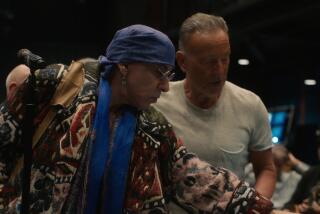A special tribute from a friend and neighbor
Julien Temple never planned to make a film about Joe Strummer. But after the co-founder of pioneering British punk band the Clash died almost five years ago, the English director counted himself among the singer-guitaristâs many friends and fans âvery deeply and badly affectedâ by his sudden demise.
âItâs partly because it was unexpected,â Temple says by phone from his home in Somerset, England, âbut also because he was such a life force.â Strummerâs beliefs in equality, anti-authoritarianism, activism and thinking for yourself amounted to a compelling code for living, the filmmaker says.
Heâd known Strummer (born John Mellor) since the Clashâs earliest days. Temple was the first to film the band, and part of that black-and-white 1976 footage forms the riveting beginning of âJoe Strummer: The Future Is Unwritten,â opening today at the Nuart. But Temple ultimately chose to follow the Sex Pistols instead, making 1980âs âThe Great Rock ânâ Roll Swindleâ (and in 2000, âThe Filth and the Furyâ).
Temple and Strummer reconnected and became close about 10 years ago. One day a friend of Templeâs wife, Amanda, who co-produced âFuture,â arrived in Somerset to house-hunt with her partner, who turned out to be Strummer.
The two men spent all night working on a hot-air balloon kit for Templeâs children. âWe woke up my kids very early, lit it up, and it started flying,â he says. âThen suddenly it caught fire, and there was this huge fireball going up into the dawn. And Joe was saying, âYeah, this is fantastic! I wanna live here, I wanna live here!ââ Soon after, he became Templeâs neighbor.
On Dec. 22, 2002, at age 50, Strummer died of a previously undiagnosed congenital heart defect. At the time, Temple was editing âGlastonbury,â his 2006 rockumentary about the massive English music festival, and encountered a sequence featuring Strummer on stage.
âA camera on a crane parked itself in front of his face, so he couldnât see the audience,â Temple recalls. Strummer tried to avoid the camera, but it kept following him.
âIn the end he started whacking it with his mike stand,â he says with a laugh. âAnd he pulled it all together with this wonderful speech about TV cameras and being filmed everywhere you go.â
This inspired Temple to make âThe Future Is Unwrittenâ as closure and comfort for those who loved Strummer but also to spread the word to people who didnât know him. It delves into his childhood and traces his movement from Clash frontman to actor/filmmaker to leader of his final band, the Mescaleros.
Incorporating home movies, film clips, old interviews, music and Strummerâs cartoons and drawings, âFutureâ is constructed as a series of conversations around campfires in different cities. This evokes the âStrummervilleâ communal fires the late musician held backstage at Glastonbury. The approach initially feels quite insular, because the dozens of participants arenât identified. You have to work to sort out whoâs who, but for Temple it was important.
âEveryone was very equal around the fire,â he says. âWhen you have a label saying âThis is the rock star . . . This is the cab driver,â youâre in some kind of hierarchy.â Strummer was against such things, he says.
Temple included Strummerâs oldest pals and family members, as well as contemporaries such as musicians Tymon Dogg and Don Letts, younger admirers like Flea and Courtney Love, director Martin Scorsese and actors such as Steve Buscemi and Johnny Depp. Also featured are Clash guitarist Mick Jones and drummer Topper Headon, but not bassist Paul Simonon.
âHe didnât want to talk,â Temple says. âI really donât know why.â
A compelling portrait emerges of a man so driven to find his path that he could be ruthlessly orthodox, especially when reinventing himself as a punk rocker and rejecting friends without a backward glance.
âJoe would jump out of his grave and strangle me if I hadnât shown all the flaws and contradictions that made him who he was,â Temple says. Ironically, his refusal to hero-worship humanizes Strummer, who eventually reconciled some dropped threads of his life, and demonstrates his uniqueness. Along with Strummerâs body of work, the documentarian sees his friendâs lasting contribution as that of a âpractical philosopher.â
âThat idea of fighting for your right to think is more and more relevant,â Temple says. âJoe had a lot of ideas that people could use in a good way and change the world.â
More to Read
Only good movies
Get the Indie Focus newsletter, Mark Olsen's weekly guide to the world of cinema.
You may occasionally receive promotional content from the Los Angeles Times.










